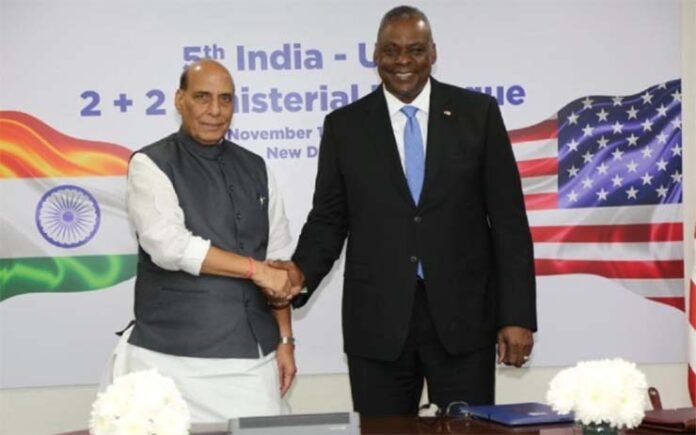Defence Minister Rajnath Singh visited the United States of America (August 23-26, 2024), met his counterpart, the US Secretary of Defence Lloyd Austin and discussed bilateral defence cooperation, defence innovation, industrial collaboration, and regional and international security issues. The key outcomes of the visit were the signing of the Security of Supply Arrangement (SOSA) and the Memorandum of Agreement between India and the US regarding the deployment of liaison officers. This commentary will delve briefly into the nature and evolution of the India-US defence partnership, opportunities, trajectories, and hurdles.
India and the United States are ‘natural allies’ wherein there is a unanimity of views and visions in the geo-strategic interests, especially in the Indo-Pacific region. India’s strategic objective is to modernise its military by acquiring sensitive and advanced technologies, bridging its capacity-capability deficit by developing home-grown know-how and skill sets in both the armed forces and the defence industry through specific programmes of co-production and co-development.
During 2015-2019, the share of the United States in India’s total defence imports rose by 14 per cent. The US defence trade with India increased from near-zero in 2008 to over US$20 billion in 2020. India has spent nearly US$20 billion in defence acquisitions from the US since 2008, including systems such as the Apache attack helicopters, Chinook heavy-lift helicopters, and M777 ultra lightweight artillery. Some of the individual deals involve the sale to India of MH-60R Seahawk helicopters for US$2.8 billion, the Apache helicopters for US$796 million, and the Large Aircraft Infrared Countermeasure for US$189 million.
Prime Minister Narendra Modi’s visit to Washington in 2023 resulted in unprecedented defence deals involving the bilateral co-production of F-414 jet engines and an agreement to supply India with MQ-9B advanced drones. The jet engine deal features an extraordinary technology transfer of up to 80 per cent, a major leap forward for India’s indigenous aircraft manufacturing capabilities.
During 2015-2019, the share of the United States in India’s total defence imports rose by 14 per cent. The US defence trade with India increased from near-zero in 2008 to over US$20 billion in 2020.
Nature and evolution of India-US defence partnership
There have been many initiatives, agreements and institutional mechanisms to bolster the defence partnership. Bilateral defence trade, defence cooperation and strategic cooperation in the Indo-Pacific region have governed this partnership. The signing of the ‘Agreed Minute on Defence relations between India and the United States’ (1995) and the ‘Next Step in Strategic Partnership’ (2004) were the starting points of engagement in civil nuclear, civilian space, high technology trade and missile defence. The ‘New Framework for India-US Defence Relations’ (2005) and its subsequent renewal in 2015, ‘Joint Declaration in Defence Cooperation’ (2013) were grounds to intensify cooperation through dialogue mechanisms, regular military exercises and exchanges, and work together in areas of defence technology transfer, licensing, trade, research, co-production and co-development.
In 2012, the Defence Trade and Technology Initiative (DTTI) was introduced to bypass the constraints of each state’s bureaucratic structures that obstruct meaningful defence cooperation by focusing on industrial cooperation. India was granted the status of ‘Major Defence Partner’ in 2016. The 2+2 Ministerial India-US dialogue added an impetus toward institutionalising this partnership. The four India-US foundational agreements (2016-2020) include the General Security of Military Information Agreement (GSOMIA); the Logistic Exchange Memorandum of Agreement (LEMOA); the Communications and Information Security Memorandum of Agreement (CISMOA); and the Basic Exchange and Cooperation Agreement for Geospatial Intelligence (BECA).
Security of Supply Arrangement
On August 22, 2024, India and the United States entered into a bilateral, non-binding Security of Supply Arrangement (SOSA). It was agreed to provide reciprocal priority support for goods and services that promote national defence. The SOSA will enable both countries to acquire the industrial resources they need from one another to resolve unanticipated supply chain disruptions to meet national security needs. There is a commitment to support each other on a priority basis for delivery requests to procure critical national defence resources. India is the 18th SOSA partner of the United States.
Guided by the US Defence Priorities and Allocations System (DPAS), the arrangement provides structural and institutional assurances for defence supplies. India, in turn, is expected to develop a common code of conduct for government and industry stakeholders, prioritising critical supplies to the US voluntarily. With SOSA in place, working groups will have the framework to communicate more frequently and take proactive steps to ensure supply chain stability in peacetime and crisis.
India and the US entered a bilateral, non-binding Security of Supply Arrangement (SOSA) on August 22, 2024, under which both countries will acquire the industrial resources they need from one another to resolve unanticipated supply chain disruptions to meet national security needs.
Defence Innovation
In 2023, the India-US Defence Acceleration Ecosystem (INDUS-X) was launched to facilitate collaboration on defence technology design and production, and to bring the Initiative on Critical and Emerging Technologies (iCET) into action. It emphasises collaboration on dual-use technologies. INDUS-X is a platform for establishing robust networks across start-ups, industry, academia, and governments, accelerating the adoption of cutting-edge technologies and enhancing the war-fighting capabilities of both sides. In the third edition of INDUS-X in September, the summit will focus on the critical role of private capital in advancing the defence innovation sector.
Deployment of Liaison officers
India and the United States welcomed signing the Memorandum of Agreement regarding the Deployment of Liaison Officers. India had earlier deployed three colonel-level officers, one each at the Hawaii-headquartered Indo-Pacific Command (INDOPACOM), the Special Operations Command (SOCOM/USSOCOM) in Florida, and the US-led multinational maritime force, called the Combined Maritime Forces (CMF), in Bahrain.
In the Indo-Pacific region, China’s military adventurism has become a key driver of the defence partnership between India and the United States, placing doubts on India’s policy of strategic autonomy.
Partnership Hurdles
India has fallen short of tapping the potentialities of DTTI. The India-US military-industrial complex needs to be engaged more and set aside bureaucratic hurdles to the relationship. India refused the offer of Lockheed Martin to relocate the F-16 Assembly line in India given the F-16’s credibility as a fourth-generation aircraft and the US decision to sell eight F-16s to Pakistan. The India-Russia defence relationship is a factor in the growth trajectory of the India-US defence relations. The US has granted India a waiver under its Countering America’s Adversaries through Sanctions Act (CAATSA), 2017, for India’s S-400 system purchase from Russia. However, India’s independent stance on the Ukraine invasion and spiralling oil purchases from Moscow has not helped relations with the United States. In the Indo-Pacific region, China’s military adventurism has made defence partnership a key driver of India-US relations, placing doubts on India’s policy of strategic autonomy.
Looking Ahead
India-US defence partnership has grown to diversify and collaborate in key and emerging areas of mutual interest. In times to come, India will be resilient enough to set up a robust defence ecosystem that facilitates prominent US and global engine manufacturers to establish their engine repair facilities in India.
-The writer is Assistant Professor in ICFAI School of Liberal Arts, ICFAI University, Jaipur.
–The writer is Assistant Professor, ICFAI School of Liberal Arts, ICFAI University, Jaipur. The views expressed are of the writer and do not necessarily reflect the views of Raksha Anirveda






